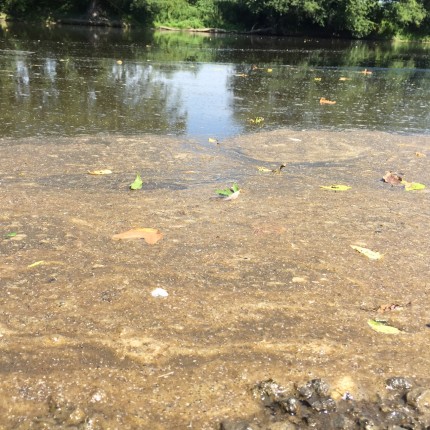Scum on the Wallkill: Not Chicken Excrement, but Still Pollution

View more images on our Flickr site
For the second time this summer, an ugly scum on the Wallkill River was observed by Craig Chapman of New Paltz Kayaking, and reported to the Department of Environmental Conservation for investigation. The first incident was reported as part of a Wallkill River boat brigade, an effort of the Wallkill River Watershed Alliance that Riverkeeper supports.
The DEC’s investigation of the report today on Wallkill River pollution has concluded that the water is covered with algae, not chicken excrement, as it appeared to be. This was the result of observations by wildlife and stream experts, not based on testing of water or the scum. (The feathers are assumed to have washed down from a congregation of geese upstream.)
If this is indeed the case, it still tells us something important about pollution in the Wallkill, just not what we expected.
The DEC has previously identified phosphorus (as well as sediment and pesticides) as a source of “stress,” to recreational use and wildlife in the Wallkill River. Phosphorus is an essential nutrient, but in excess it can lead to degrade water quality and habitat. The DEC identifies agricultural runoff, streambank erosion and hydromodification (ie, the agricultural channels upstream) as the “known” sources of this pollution, as well as stormwater runoff and streambank erosion as “suspected” sources.
Other sources of nutrients (not identified specifically by the DEC as of concern in the Wallkill, but possibly relevant) may include septic systems and sewage treatment plants – even those treating to required standards, since neither septics nor most plants in the region remove nutrients from effluent. The other part of this story are the dams on the Wallkill. By altering the natural flow of the river, the dam at Dashville has changed this stretch from a free-flowing river to something more like a long lake. Low flow, high temperature and high nutrient concentrations are the right conditions for algae to flourish. The problem of excess nutrients may be there more consistently, but it’s only apparent under conditions such as these. (The dams also block the movement of aquatic organisms and trap sediment, and have other important consequences for the health of the ecosystem.)
This episode seems to be a violation of New York State Water Quality Standards for nutrients (nitrogen and phosphorus). The standards state that nutrients should not be present “in amounts that result in the growths of algae, weeds and slimes that will impair the waters for their best usages.” The DEC-designated best uses of the Wallkill in this stretch are primary contact recreation (like swimming) and fishing. If algal growth looks ugly enough to be mistaken for chicken manure, it seems to meet the test for violating the standard.
What can be done? Addressing nutrient pollution is a longterm and watershed-scale problem. Individuals should at least make sure they are following the law when using lawn fertilizers, and never spread fertilizers near water or in winter.
